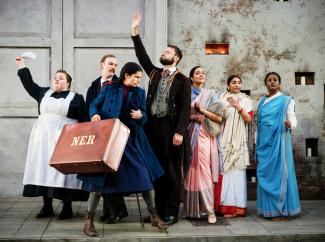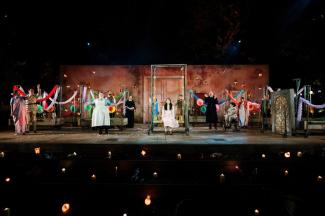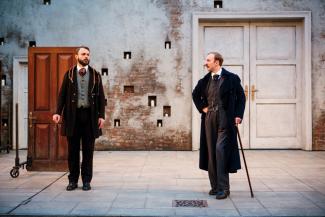Stammering & The Secret Garden

A recent theatre production of The Secret Garden shone a light on attitudes to differences by including a character who stammered. STAMMA volunteer John Russell tells us all about it.
Being familiar with the story of The Secret Garden, I was intrigued to learn that a recent production of the classic 1911 novel by Frances Hodgson Burnett, at Regent's Park Open Theatre in London, featured a new character who stammers. How would stammering be portrayed and addressed? I wondered.
Plot
Firstly, for anyone unfamiliar with the plot, here's a short summary. The Secret Garden tells the story of 11-year-old Mary Lennox. In the opening scene, set in Kolkata, India, the seemingly spoilt Mary is the sole survivor of a cholera outbreak which sweeps through her family home. She is sent to Yorkshire to stay with her aunt and uncle, the Lord and Lady Craven.
While exploring her new surroundings, Mary discovers a key which unlocks an ivy-covered door that leads to an overgrown secret garden. She is deterred from finding out more by the gardener, which fuels her curiosity over this mysterious garden.

One night, Mary hears a strange crying-like sound. She investigates and discovers its source, a boy called Colin, whom she finds out is her cousin. Colin is bed-bound and tells Mary he's suffering from a chronic illness and can't leave his room. Mary promises to return and tell Colin more about the garden. Mary later sneaks Colin out to the garden in a wheelchair, which begins a process of opening up the world around him.
Portrayal
At the matinee I attended on one blisteringly hot afternoon this July, I sat with baited breath to see who the stammering character would be. It turned out to be Dr Harold Craven, Colin's uncle, played here by George Fletcher, who, interestingly, stammers himself. (Editor's note: read George's article in which he talks about playing a character who stammers).
Harold had silent blocks when he spoke; his apparent struggle barely raised an eyebrow from the other characters and wasn't commented on. He later, during a particularly difficult block, smacked his thigh to escape the tension.
It wasn't a case of "Oh, poor stammerer, look at him".
At one point in Act Two, Harold saw Colin out of bed, wheeling himself around in his chair. Harold said to Colin, "You seem to be getting……" and then nothing. The sentence wasn't completed, leaving me — and the audience — to think, What was he going to say?. The lesson here, I felt, was to not finish the sentences of a person who stammers by predicting what they're going to say.

Apparently, the writer Holly Robinson and director Anna Himali Harold wanted to explore disability in a number of different ways for this production, and how society closes doors to people in different ways. There was a really interesting scene which brought these attitudes, and acceptance of differences, into focus. Mary's uncle, Lord Craven, used a walking stick, and one character commented that he wouldn't be viewed as a 'cripple' (a now outdated term of course) if he had been accepted for how he walks. Lord Craven talks about searching for a cure for his son's condition, which is challenged by the cast. At another point, Harold said, humorously, "I used to put pebbles in my mouth and I can still taste the dirt," a reference to the method used by the Greek orator Demosthenes, who famously filled his mouth with pebbles and shouted at the waves in an attempt to cure his stammer. Acknowledgement and understanding goes a long way, rather than the need to 'fix' people. Embracing differences — in any context — is far more important. It is worth bearing in mind, of course, that not all people who stammer necessarily see stammering as a disability — or want to be identified as being disabled.
...hopefully the audience gained an understanding of what it's like to be a person who stammers.
All in all, Harold's stammer was an accurate portrayal, and was done so without seeing the character as a victim. It wasn't a case of "Oh, poor stammerer, look at him". He just happened to stammer and it wasn't used to hint at a character defect.
What might have made the stammering character more impactful, I felt, would have been for Harold to have had a few lines where he described what life is like as a person who stammers, and how he copes with the treatment he receives. Then again, there was a scene where Colin spoke over Harold while he stammered, which Mary pulled him up on, which demonstrated to the audience the treatment that people who stammer have to put up with.
The makers of this version of The Secret Garden deserve much credit for being inclusive of both the stammering and disability community, which for me, worked really well, and hopefully raised awareness with the audience. I left the Open Air Theatre at Regent's Park, delighted that the subject of stammering — and disability — had been addressed in a major production, and that the audience would, hopefully, have gained had an understanding of what it's like to be a person who stammers and disability in general.
The Secret Garden ran for a short spell at Regent's Park Open Air Theatre this summer, ending on 20th July. Thank you very much to John Russell for contributing this article for the STAMMA site.

































